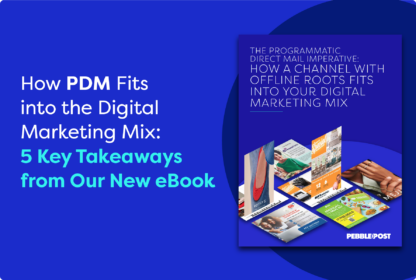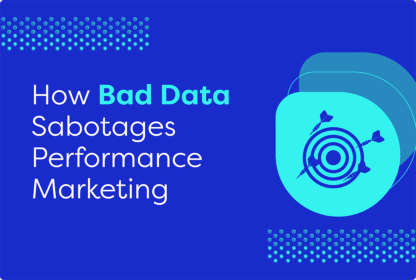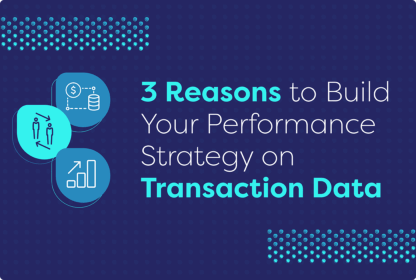Four years ago, we talked about the explosion of e-commerce, an uptick in online and social media usage, and a surge in spending on digital advertising channels.
The state of affairs looks quite different today. Consumers engage less with online media, evidenced by plateauing YoY growth in time spent.
In a recent Insider Intelligence podcast, analyst Jeremy Goldman discusses three trends redefining how consumers spend their time and money in 2024. Here’s my POV on what these changes mean for marketers—and why hybrid channels like Programmatic Direct Mail are poised to capture even more advertising share.
1. Less time online = new offline ways to market
Insider Intelligence forecasts that we’ll only see a 3-minute YoY growth in time spent on media this year and a 2-minute YoY growth next year.
This is a trend we’ve seen coming: digital fatigue is real. We get exposed to anywhere from 4,000 to 10,000 ads daily—and it’s getting old. Two-thirds of consumers want fewer marketing messages, and a little over a quarter feel bombarded by these communications. Consumers are building subconscious mechanisms to tune out digital ads as there is increasingly more competition to get in front of them online.
To call yourself an omnichannel brand, you must look outside the “omni-digital” lens to meet consumers offline.
Channels like PDM enable marketers to tie high-fidelity, digital intent signals to offline engagement so they engage only consumers in the market for a product or service. Unlike weeding through the dozens of email messages or avoiding clicking on one of the hundreds of ads we might receive in a day, we typically only get a few pieces of mail. This makes it far easier for consumers to make a conscious and tactile decision to pick up a postcard. Even if they don’t act on the offer right away, the consumer, if interested, might put the postcard on their fridge, counter, or desk and come back to it later. They’re less likely to flat-out ignore it.
Most of us look forward to this part of the day with delight, not dread (unless you have a lot of bills coming your way).
2. Toggling between physical and digital is a new form of engagement
It’s not just that consumers are overwhelmed by digital media—after years of having no choice but to shop online, they want to return to a physical store experience.
According to Insider Intelligence’s forecast, E-commerce represented just 15.6% of our retail sales last year. By 2027, US consumers will spend only 1 in 5 dollars online.
As retailers improve the customer experience for physical stores, they also have to drive foot traffic to them. Because PDM engages people in the real world, it is a very effective way to get consumers into established and new stores.
For example, during a sale, a large national furniture retailer with two retail chains spanning more than 120 locations needed help driving additional traffic to their newly remodeled stores in three top markets: Chicago, Detroit, and D.C. The company launched a geo-specific prospecting campaign using PDM and saw 1,113 in-store conversions across the three locations. In addition, they saw a combined 128 online conversions, proving that focusing on offline engagement instead of just omi-digital tactics can boost both store and e-commerce sales.
There is also an advantage of PDM from a measurement and attribution standpoint. Because the foundation of PDM decision-ready audiences is deterministic household addresses, brands can confidently match online and offline transactions. While PDM is a digital solution that activates in physical media, if someone expresses intent within 24 hours, a customized postcard is in the mail, meaning the ad connects to actual media.
3. It’s time to try new formats
Given the new shopping era we’re living in, in addition to the deprecation of legacy digital identifiers and targeting tactics, advertisers would be wise to explore new media formats starting now.
Nothing breaks through the clutter like PDM. A neuroscience study from Canada Post and True Impact shows paper beats digital regarding ad recall and driving consumer actions. There was 70% higher recall, 21% less cognitive effort to process, and 20% higher motivation in response. We have brands across verticals tell us regularly that PDM is their highest-performing channel.
A huge factor that gives us tailwinds in 2024 beyond the power of direct mail in light of digital saturation is that our data quality lets us get to the right people within their decision-making window. We see $1 billion in transactions and have access to nearly every consumer and household with intent data. Like retail, we see the same outcomes in banking, travel, and insurance. The quality of the data and channel activation drive the success.
If you think about it, PDM is like the founding father of addressability. The PebblePost Graph is a first-party data-focused solution that can accurately resolve an identifier to an individual and then connect it to a household. The channel, therefore, helps with reach and scale—putting businesses like ours in a powerful position where we are not as concerned about cookie deprecation as other solely digital providers are.
Make 2024 the year of PDM
With the right strategy, data, and technology behind PDM, a brand can adopt an entirely new, performance-driven channel that doesn’t require heavy investment from a creative or internal resources standpoint. Get in touch today to learn how to get started.



